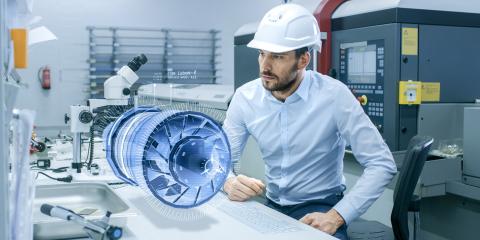The impact of disruptive technology on products and production

The impact of disruptive technology on products and production
Belgian companies put artificial intelligence and big data analysis on top of their list of most disruptive technologies for their processes. This appears from a study among 122 companies that we performed at the end of 2019. We are definitely not alone in this. Worldwide, 92% of the companies indicate that their expenditures will mainly focus on the collection and analysis of in-house data – for instance from production and logistic processes, the use of their product at the customer and suchlike – and the subsequent actions resulting from this.
Investments in smart sensors and the Internet-of-Things complete the top three. These three technologies are clearly linked to one another and all contribute to the digital transformation.
The digital transformation is the incremental and disruptive adaptation of products and/or production to the digital age. The use of digital technologies such as artificial intelligence or smart sensors leads to new business processes and new customer experiences. In this way, organisations can meet changing market demands and, in the end, create new business models. On the other hand, equal attention should be paid to a new corporate culture and the recruitment of digital talent. This is necessary to be able to reap the long-term benefits of the comprehensive digital opportunities that are available today.
In this article, we will tell you more about these three disruptive technologies.
1. Big data analysis and artificial intelligence
Big data is about collecting data generated by, for instance, machines or vehicles during their use. After having structured these big data, artificial intelligence algorithms can generate insights on these data. This is done on different levels, but the ultimate aim is being able to predict on the basis of (historical) data what will happen when and why. This knowledge makes well-informed (whether or not autonomous) decisions possible and thus enables companies to profit optimally from opportunities and avoid risks. In this way, data are transformed into actionable intelligence. Some potential applications are, amongst others, zero-fault production, operator-supporting functionalities or conditional maintenance.
2. Internet-of-Things
Not only people are almost continuously online, the same applies to systems. A smart thermostat measures when the temperature drops and will respond to this. It makes sure you arrive in a warm house in the evening and it can be controlled remotely. This is no different in a production environment. Machines can be connected with one another and with the cloud. The industrial Internet-of-Things (IIoT) not only enables to programme or control machines remotely, these machines can also exchange data with one another.
IIoT is expected to boom in the coming years. The results of the study show that the awareness about it is growing. Furthermore, the price of chips and sensors is decreasing drastically, which improves their implementation. Thanks to IIoT, actionable intelligence will become the new standard.
However, we are still facing a number of thresholds impeding total market penetration.
- First, we need a sufficiently fast and reliable internet connection. 5G will play an important role in this. Without this new communication technology, digitisation is not possible because 4G is often not strong enough. To maintain our technological edge, industry and associations alike are calling for a rapid introduction of the 5G network. The first industrial applications in Belgium are scheduled for the end of 2019, amongst others in the port of Zeebrugge.
- Secondly, IT (information technology) and OT (operational technology) must grow towards one another, with OT taking the lead. By connecting machines, these no longer are an exclusive part of the operational side of the business, IT must connect and secure data and implement the cloud system. As a result, a failure in an industrial compressed air plant is no longer a mere operational problem but will also require assistance from IT. It is crucial that organisations that want to implement IIoT break the walls between both divisions.
3. Smart sensors
To connect systems, they are equipped with sensors. Their role is detection, in the broadest sense of the word: they detect a change in the system or in the environment and send this information to the cloud or another system, such as a processor. Therefore, sensors are one of the building blocks of any smart, cyber-physical system. Other building blocks are the actuator, the energy system (e.g. a battery) or the controller.
Sensors are not only becoming less expensive (cf. Above), their performances have also improved significantly. An example are hyperspectral cameras used for quality control in the food industry. As they combine spectroscopy with digital image processing, they can "see" much more than an ordinary camera and can detect certain deficiencies and even quasi invisible fungi.
To optimally prepare companies for all these changes, we’ve worked out a roadmap, enabling them to start making their products and production future-proof. The use of disruptive technologies such as artificial intelligence, IIoT and smart sensors is of crucial importance here.
